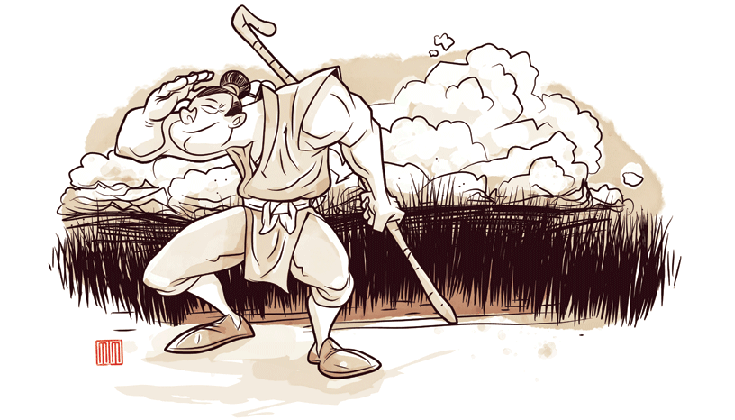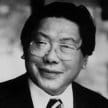In Zen’s famed 10 oxherding pictures, the ox is enlightenment and the herder is you, the meditator. Created by 12th-century Chinese master Guo-an Shi-yuan, the oxherding pictures have mapped the path for Buddhist practitioners ever since, inspiring countless commentaries and new renderings. Here is a contemporary take by graphic artist Mark T. Morse, with commentary by Boundless Way Zen teacher Josh Bartok and a Vajrayana perspective from the late Chögyam Trungpa Rinpoche.
1. Searching
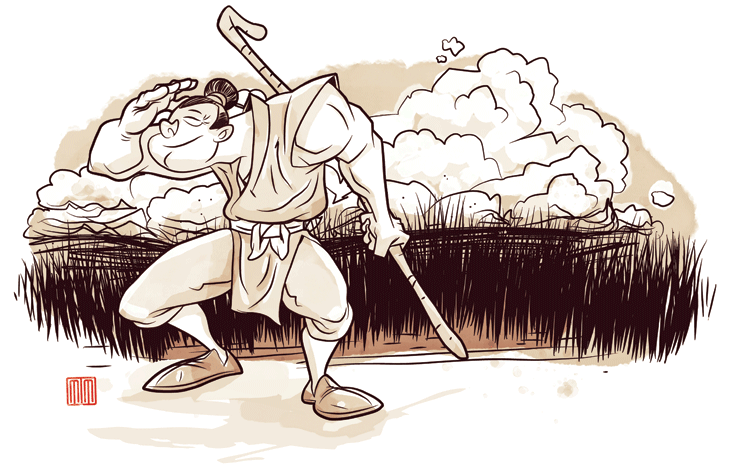
Josh Bartok
Here we become aware of our spiritual questions, perhaps Where can I be free from suffering? Who am I? Why does it hurt so much to be me? How can there be such evil? or What is my True Nature? We may be motivated by fear of death—or fear of life. This is raising the mind of enlightenment.
Chögyam Trungpa
The inspiration for this first step, which is searching for the ox, is feeling that things are not wholesome, something is lacking. That feeling of loss produces pain. You are looking for whatever it is that will make the situation right. You discover that ego’s attempt to create an ideal environment is unsatisfactory.
2. Seeing the footprints
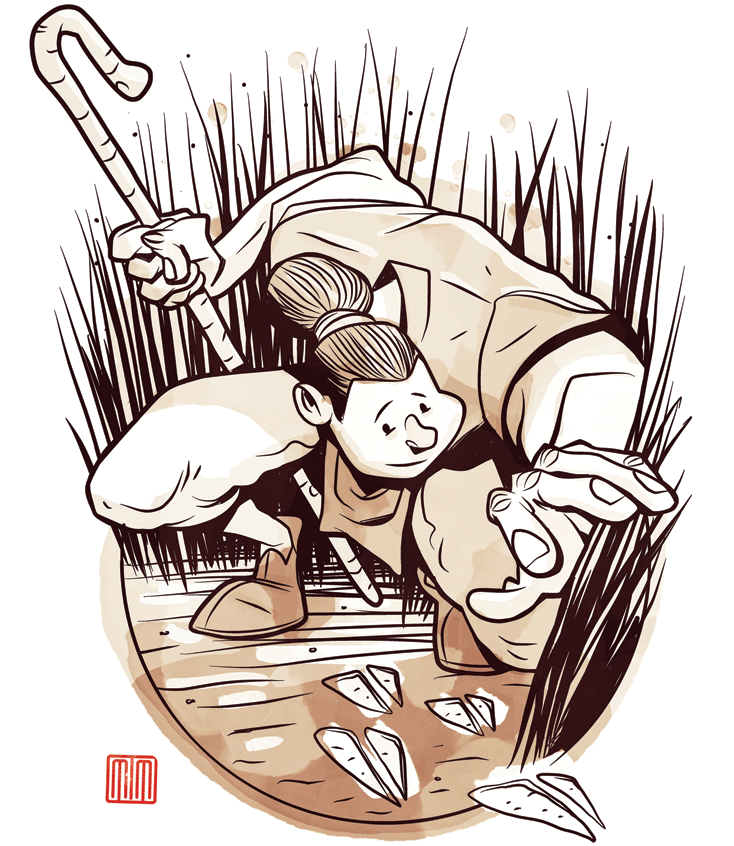
Josh Bartok
Here we embark in earnest on the path. We discover the tools of dharma exploration, the teachings of the ancestors. When we first encounter meditation, though we may not understand it, there is a glimmer of rightness, a dimly perceived potential of coming home. Pushing aside weeds and grasses, we wonder how we might express our Original Face.
Chögyam Trungpa
By understanding the origin you find the possibility of transcending this pain. This is the perception of the four noble truths. You see that the pain results from the conflicts created by ego and discover the footprints of the ox, which are the heavy marks of ego in all play of events. You are inspired by unmistakable and logical conclusions rather than by blind faith.
3. Glimpsing
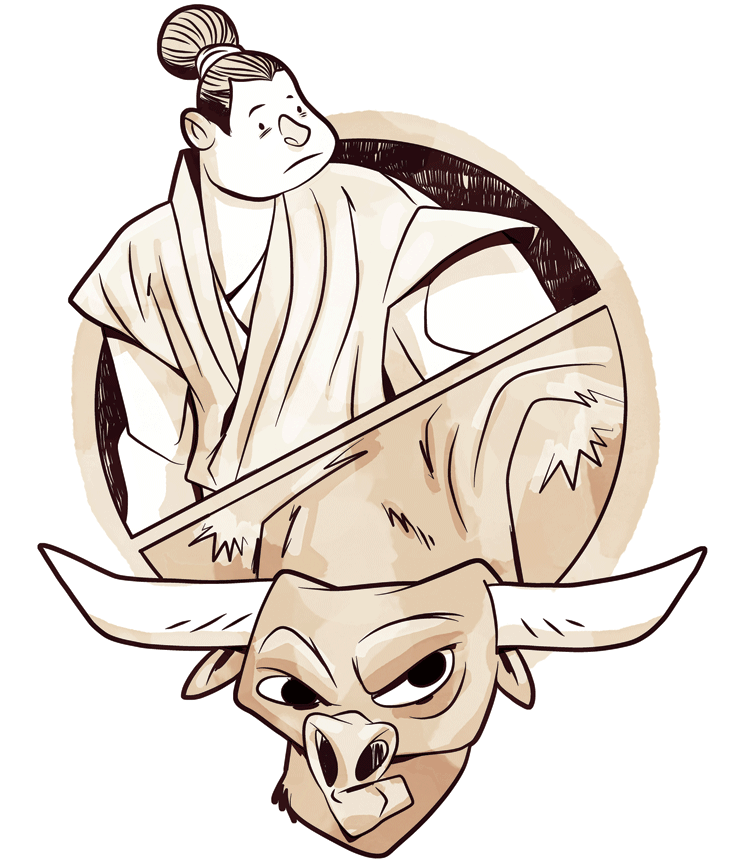
Josh Bartok
Here we see for ourselves that the buddhas and ancestors and our own teachers have not been deceiving us. We glimpse the Great Matter through a small opening, a small intimation. Perhaps this comes with fireworks and, in our delusion, we think we’ve seen the whole ox, though all we’ve seen is the head. But that tiny tail!—what a wonderful thing it is.
Chögyam Trungpa
You are startled at perceiving the ox and then, because there is no longer any mystery, you wonder if it is really there; you perceive its insubstantial quality. You lose the notion of subjective criteria. When you begin to accept this perception of non-duality, you relax, because you no longer have to defend the existence of your ego. Then you can afford to be open and generous. You begin to see another way of dealing with your projects and that is joy in itself, the first spiritual level of the attainment of the bodhisattva.
4. Catching
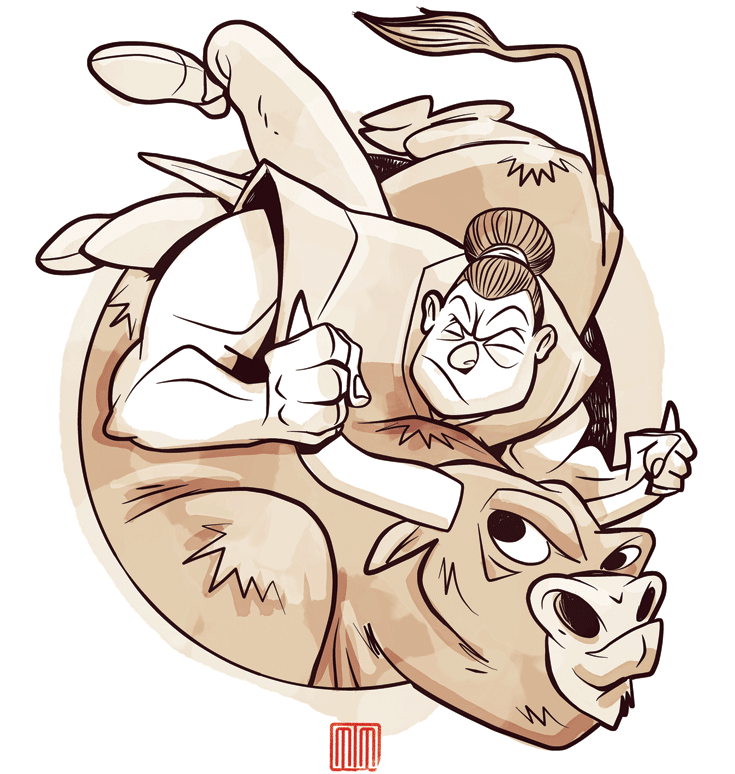
Josh Bartok
Having become oriented to the nature of the spiritual work to be done, here we must begin to truly do it. Conditioned by eons of karmic habit, the work can be painful and slow. We see just how much of a mess our minds are, how quickly and inevitably we respond from grasping and aversion—and perhaps we even see no change at all. This is a period of excruciation and great effort, the work of lifetimes.
Chögyam Trungpa
Seeing a glimpse of the ox, you find that generosity and discipline are not enough in dealing with your projections, because you have yet to transcend aggression completely. You have to acknowledge the precision of skillful means and the simplicity of seeing things as they are, as connected to fully developed compassion. The subjugation of aggression cannot be exercised in a dualistic framework—complete commitment to the compassionate path of the bodhisattva is required, which is the further development of patience and energy.
5. Taming
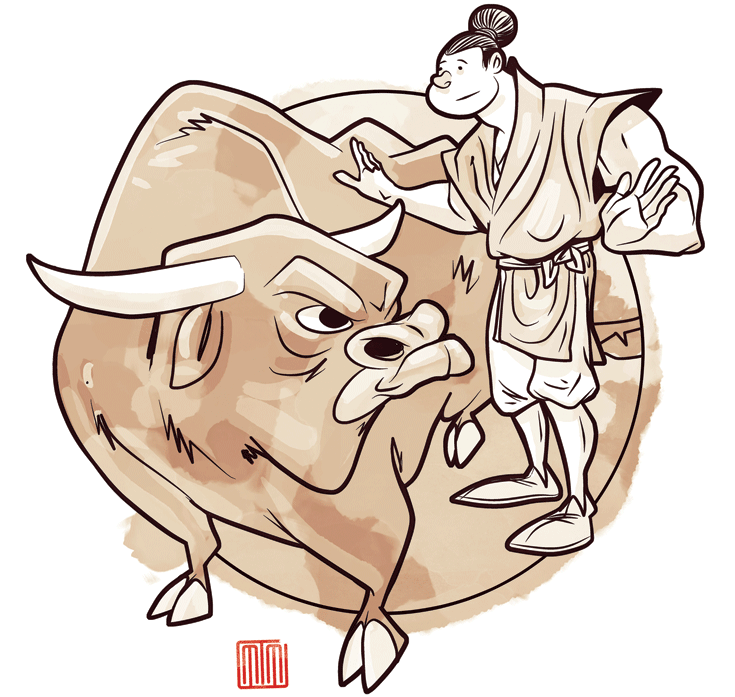
Josh Bartok
Here at last we begin to see that patterns can change, habits can be unlearned, and compassion and wisdom truly can be realized and practiced. We rely on the support of the three treasures—buddha, dharma, and sangha—because we can’t do it by ourselves, and nobody else can do it for us either. In diligent application, patience and generosity toward ourselves and others is the moment-by-moment practice.
Chögyam Trungpa
Once caught, the taming of the ox is achieved by the precision of meditative panoramic awareness and the sharp whip of transcendental knowledge. The bodhisattva has accomplished the transcendent acts (paramitas)—not dwelling on anything.
6. Riding home
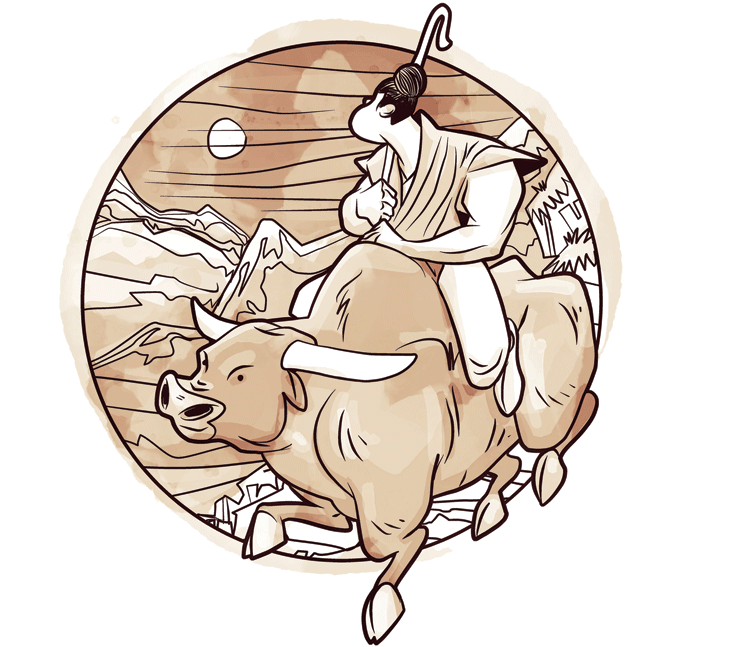
Josh Bartok
Here we can begin to loosen our grips on our minds, on our stories of how we and the world are or should be, and even on the tools of the dharma. We play freely on the iron flute with no holes. Entrusting ourselves to the universe, we receive all that comes and we release all that goes.
Chögyam Trungpa
There is no longer any question of search. The ox (mind) finally obeys the master and becomes creative activity. This is the breakthrough to the state of enlightenment. With the unfolding of the experience of Mahamudra, the luminosity and color of the mandala become the music which leads the ox home.
7. Transcending other
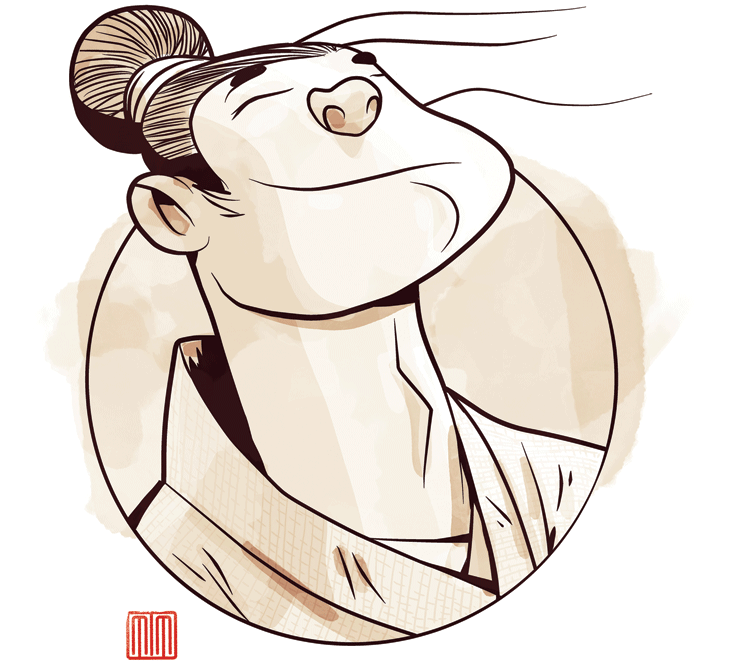
Josh Bartok
Having returned home, here we can rest. We’ve lost the ox, we’ve found the ox—who can even remember what that search was for? Original Face? As soon as it is mentioned, the arrow sinks in stone. Yet in this very place, where fundamentally nothing is acquired, we really do acquire it.
Chögyam Trungpa
Even that joy and color become irrelevant. The Mahamudra mandala of symbols and energies dissolves into Maha Ati through the total absence of the idea of experience. There is no more ox. Crazy wisdom has become more and more apparent and you totally abandon the ambition to manipulate.
8. Transcending self-and-other
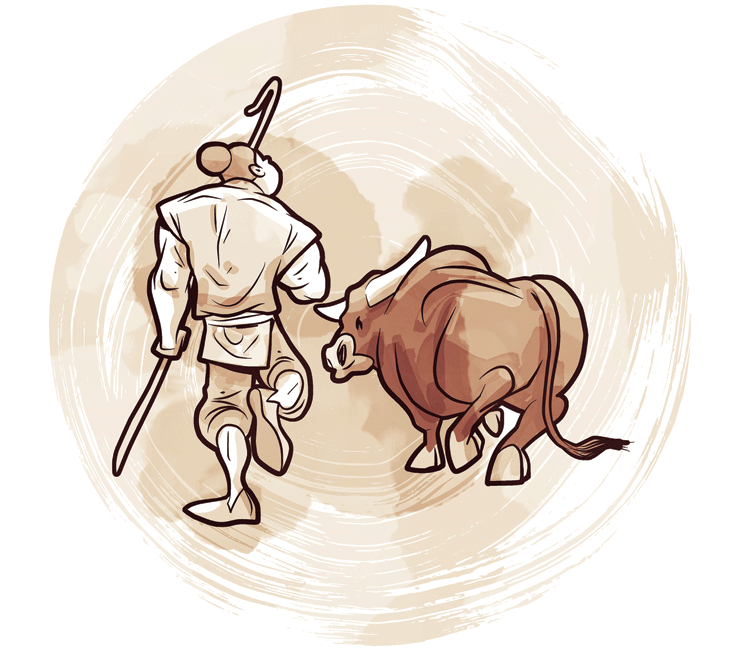
Josh Bartok
Here, in this one bright pearl of a universe, there is not even a single thing. No self, no True Nature; no delusion, no wisdom; no seeking, no finding. No seeing, hearing, smelling, tasting, touching—and of utmost importance, no knowing. There is also no dharma. And even emptiness is empty.
Chögyam Trungpa
This is the absence of both striving and non-striving. It is the naked image of the primeval buddha principle. This entrance into the dharmakaya is the perfection of non-watching—there are no more criteria and the understanding of Maha Ati as the last stage is completely transcended.
9. The source
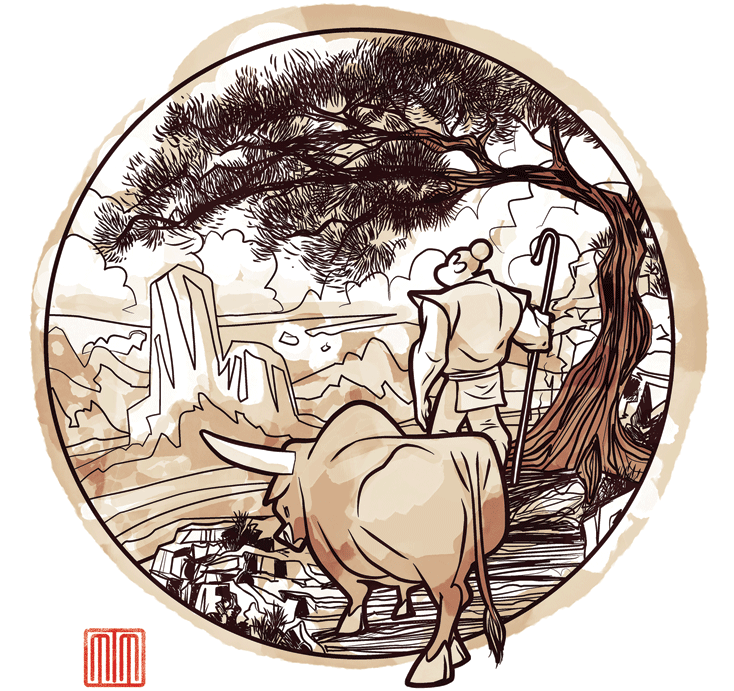
Josh Bartok
And yet… and yet… Though form is indeed exactly emptiness, form is also form. The one bright pearl manifests as the myriad things. From the beginning, nothing was ever missing. Time after time, just this has always been it. The universe of emptiness arises thus.
Chögyam Trungpa
Since there is already such space and openness and the total absence of fear, the play of the wisdoms is a natural process. The source of energy which need not be sought is there. It is that you are rich rather than being enriched by something else. Because there is basic warmth as well as basic space, the buddha activity of compassion is alive and so all communication is creative. It is the source in the sense of being an inexhaustible treasury of buddha activity. This is, then, the sambhogakaya.
10. Returning
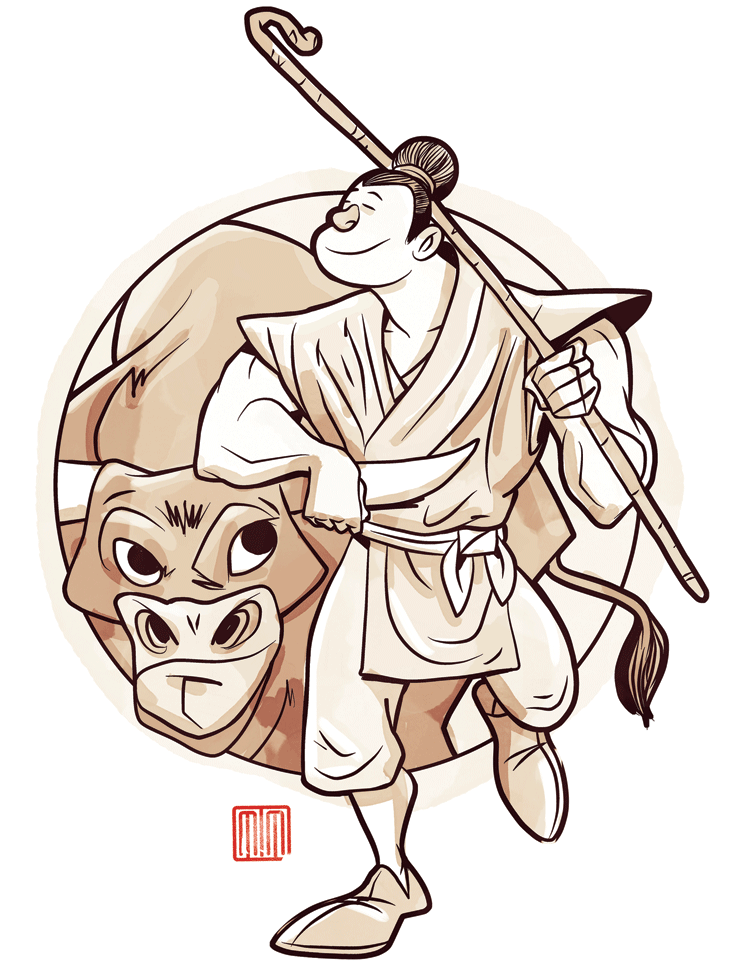
Josh Bartok
Here we dive back into the great fertilizing muddle of life and death. We partake and participate. Our debt to the buddhas and ancestors, and to our own teachers, can never be paid back—but we vow together with all beings to pay it forward, ceaselessly.
Chögyam Trungpa
Nirmanakaya is the fully awakened state of being in the world. Its action is like the moon reflecting in a hundred bowls of water. The moon has not desire to reflect, but that is its nature. The state is dealing with the earth and ultimate simplicity, transcending following the example of anyone. It is the state of “total flop” or “old dog.” You destroy whatever needs to be destroyed, you subdue whatever needs to be subdued, and you care for whatever needs your care.
Chögyam Trungpa Rinpoche’s commentary is excerpted from Mudra, ©1972 by Chögyam Trungpa. Reprinted by arrangement with The Permissions Company, on behalf of Shambhala Publications.
